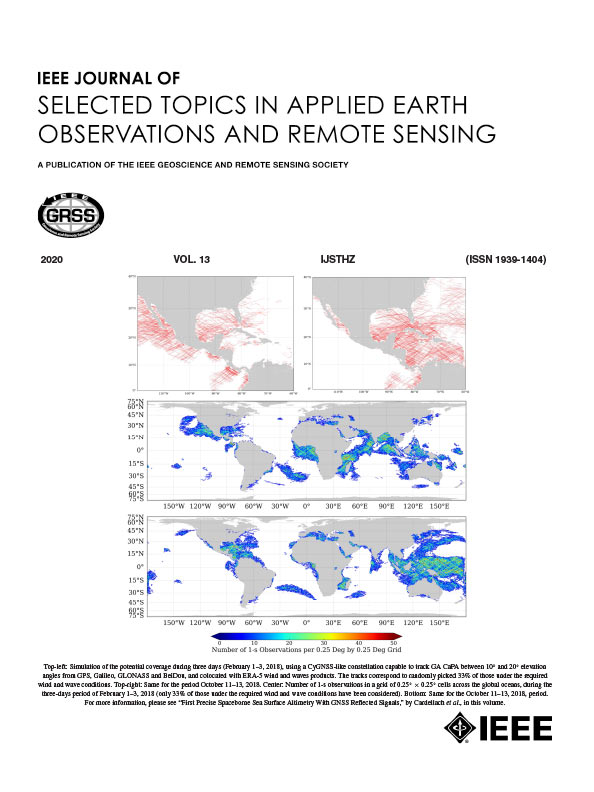The Spatio-Temporal Weighted Adjustment Network for Remote Sensing Image Change Detection
IF 5.3
2区 地球科学
Q1 ENGINEERING, ELECTRICAL & ELECTRONIC
IEEE Journal of Selected Topics in Applied Earth Observations and Remote Sensing
Pub Date : 2025-08-22
DOI:10.1109/JSTARS.2025.3601996
引用次数: 0
Abstract
With the rapid advancement of deep learning, substantial progress has been achieved in remote sensing change detection (CD). However, there are still two key challenges. First, the widespread scene context interference hinders the accurate detection of change regions; second, the existing methods are difficult to simultaneously detect change regions across different scales. To address these issues, this article presents a cross-spatio-temporal weight adjustment network (CWA-Net) with three core optimizations. First, we propose a cross-spatio-temporal differential fusion attention mechanism, which utilizes differential features extracted by the backbone network to enhance bitemporal features. Through the coordinated use of multiple attention mechanisms and channel exchange, the mechanism promotes deep interaction and fusion of bitemporal features, effectively reinforcing change region representations while mitigating scene interference. Second, we design a multiscale selection and aggregation module that adaptively selects and aggregates the optimal scale features from multiscale features, enhancing the model’s capability to capture change regions at different scales. In addition, we put forward a two-type change-feature complementarity strategy, which reweights change features extracted via subtraction and concatenation during the aggregation of multiscale feature maps, thereby enhancing feature complementarity and enriching change information. Finally, extensive experiments on four remote sensing CD datasets demonstrate that CWA-Net, based on a simple backbone network ResNet18, outperforms existing state-of-the-art SOTA methods.遥感图像变化检测的时空加权平差网络
随着深度学习技术的快速发展,遥感变化检测技术取得了长足的进步。然而,仍然存在两个关键挑战。首先,广泛的场景背景干扰阻碍了变化区域的准确检测;其次,现有方法难以同时检测不同尺度的变化区域。为了解决这些问题,本文提出了一个具有三个核心优化的跨时空权重调整网络(CWA-Net)。首先,我们提出了一种跨时空差分融合注意机制,利用骨干网提取的差分特征增强双时间特征。该机制通过协调使用多注意机制和通道交换,促进双时间特征的深度交互和融合,有效增强变化区域表征,同时减轻场景干扰。其次,设计了多尺度选择和聚合模块,从多尺度特征中自适应选择和聚合最优尺度特征,增强了模型捕捉不同尺度变化区域的能力;此外,我们提出了两种类型的变化-特征互补策略,该策略在多尺度特征图聚合过程中对通过减法和拼接提取的变化特征进行重新加权,从而增强特征互补性,丰富变化信息。最后,在4个遥感CD数据集上的大量实验表明,基于简单骨干网ResNet18的CWA-Net优于现有的最先进的SOTA方法。
本文章由计算机程序翻译,如有差异,请以英文原文为准。
求助全文
约1分钟内获得全文
求助全文
来源期刊
CiteScore
9.30
自引率
10.90%
发文量
563
审稿时长
4.7 months
期刊介绍:
The IEEE Journal of Selected Topics in Applied Earth Observations and Remote Sensing addresses the growing field of applications in Earth observations and remote sensing, and also provides a venue for the rapidly expanding special issues that are being sponsored by the IEEE Geosciences and Remote Sensing Society. The journal draws upon the experience of the highly successful “IEEE Transactions on Geoscience and Remote Sensing” and provide a complementary medium for the wide range of topics in applied earth observations. The ‘Applications’ areas encompasses the societal benefit areas of the Global Earth Observations Systems of Systems (GEOSS) program. Through deliberations over two years, ministers from 50 countries agreed to identify nine areas where Earth observation could positively impact the quality of life and health of their respective countries. Some of these are areas not traditionally addressed in the IEEE context. These include biodiversity, health and climate. Yet it is the skill sets of IEEE members, in areas such as observations, communications, computers, signal processing, standards and ocean engineering, that form the technical underpinnings of GEOSS. Thus, the Journal attracts a broad range of interests that serves both present members in new ways and expands the IEEE visibility into new areas.

 求助内容:
求助内容: 应助结果提醒方式:
应助结果提醒方式:


